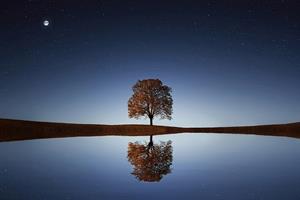PDF chapter test TRY NOW
Metaphor:
A metaphor is a figure of speech that makes an implicit, implied, or hidden comparison between two things that are unrelated, but which share some common characteristics.
Metaphors are used to dramatize thoughts to emphasize and elevate the expression to a higher intensity.
Metaphors have comparison which is indirect. For instance, the sentence, "Riya is like a tigress" is a simile and the sentence "Riya is a tigress" is a metaphor. While both the sentences mean the same, we can easily understand that "Riya" is compared to a tigress in a more prominent and direct tone in the first sentence. In the second sentence, it looks as if the speaker is saying that Riya is a tigress rather than she looks or behaves like one.
Example:
1. The calm lake was a mirror - In the real sense, the lake cannot be a mirror. However, it can have the qualities of a mirror. It can stay still and can reflect things. Hence, the sentence means that the calm lake was able to reflect things very clearly.

The reflection of the tree seen on the lake is as good as the ones seen on mirrors
2. Chaos is a friend of mine - The literal meaning claims that 'chaos is a friend of the speaker'. The metaphorical meaning is that 'chaos has been a part of the speaker's life for a long time'.
3. The sun is a golden ball - The sentence doesn't mean that sun is ball made of gold or that you could run around and play with it. It actually means that 'the sun is in the colour of gold (or fire) and is in the shape of a ball.
Metaphors used in the poem "Meadow Surprises":
- Walk softly through the velvet grass: The line means that you should walk softly through the grass that is as soft as velvet.
- A butterfly unfolding its drinking straws: The butterflies do not carry drinking straws with them. The line merely means that the butterflies are unfolding its sucking tube which looks like a drinking straw.
- A dandelion has turned into airy parachutes: The line doesn't mean that the dandelion has turned into parachutes literally, but rather it has turned to something like a parachute which is capable of moving slowly in the air.
Alliteration:
Alliteration is the occurrence of the same sound, if not a letter, at the starting of two or more words in a single line, in a poem.
Example:
1. The slender smiling girl.
2. The song of sweet birds.
3. Black bug bit a bear.
4. Practise the piano.
2. The song of sweet birds.
3. Black bug bit a bear.
4. Practise the piano.
5. Feel the phone on your face.
What are the uses of alliteration?
1. It creates a rhythm, similar to rhyming words.
2. It emphasizes the importance of phrases.
3. Mostly used in tongue-twisters.
1. It creates a rhythm, similar to rhyming words.
2. It emphasizes the importance of phrases.
3. Mostly used in tongue-twisters.
Alliteration used in the poem "Meadow Surprises":
- Walk softly through the velvet grass.
- And listen by the brook.
- Who is sitting very still.
- When he hops you will.
- A dandelion whose fuzzy head
- The ant’s amazing mound.
- And many things to tell.
Important!
Note: The line "dandelion whose fuzzy head" is an example of alliteration because the words "whose" and "head" begin with the same sound "/\(h\)/". On the other hand, the line "to sip the nectar up" from the poem doesn't contain alliteration even though the letter "t" is repeated. It is because the letter "t" in the word "to" sounds different from the "t" in the word "the". "To" begins with the sound /\(t\)/ and "the" begins with the sound /\(ð\)/.
Imagery:
Imagery means using imaginative language to represent objects, actions, and ideas in such a way that it appeals to our physical senses. A writer helps the reader to visualize or to see in their minds what is being described. The images should appeal to one or more of the five senses: sight, hearing, touch, taste or smell.
Example:
1. It was dark and dim that night.
The words “dark” and “dim” are visual images; (that appeal to our eyes).
The words “dark” and “dim” are visual images; (that appeal to our eyes).
2. The kids were screaming and laughing in the classroom.
“Screaming” and “laughing” appeal to our sense of hearing; (that appeal to our ears).
“Screaming” and “laughing” appeal to our sense of hearing; (that appeal to our ears).
3. Rani whiffed the fragrance of the fresh rose blossoms.
“Whiff” and “fragrance” evoke our sense of smell; (that appeal to our nose).
What are the uses of imagery?
1. The concept is made easier to understand, as the reader visualizes it.
2. It makes the concept easier to remember.
1. The concept is made easier to understand, as the reader visualizes it.
2. It makes the concept easier to remember.
Imagery used in the poem "Meadow Surprises":
- Walk softly through the velvet grass
- A butterfly rest upon a buttercup
- Unfold its drinking straws
- To sip the nectar up
- A rabbit who is sitting very still;
- A dandelion whose fuzzy head
- Has turned to airy parachutes
- That flutter when you blow
- A nest beneath tall grasses
